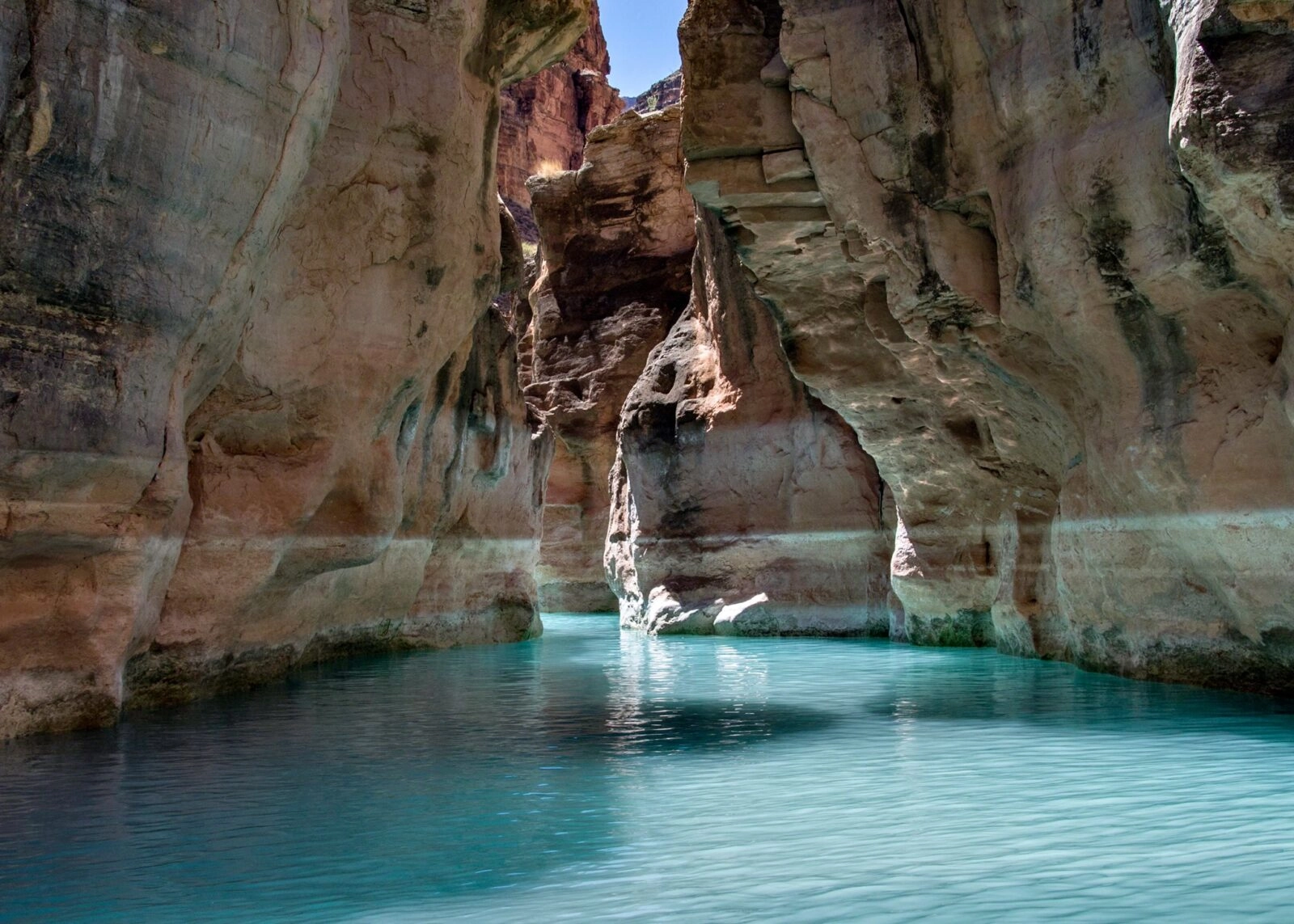Grand Canyon rafting trips in July and August amazing—here are 5 reasons why! Perhaps our most asked question in the Hatch office is:...


People on our trips are often stunned by the bright blue waters flowing through Havasu Canyon and the Little Colorado—especially when compared with the muddy waters of the main Colorado River. Walking up this canyon and seeing the almost luminescent water is like entering a whole new world.
In fact, the water is so striking that the people of the Havasupai Tribe, the Havasu Baaja, took their name from it. Havasu means blue green water; Pai and Baaja both mean people. For over 1,000 years, the Havasu Baaja have called the village of Supai—near the bright blue creek in Havasu Canyon—home.

A calcium carbonate deposit of travertine along a trail in Grand Canyon.
The answer lies in its chemical composition. The Little Colorado River and Havasu Creek are heavy with a mineral called calcium carbonate which gives the river its bright, vibrant blue color.
The waters here aren’t actually that much bluer than the rest! But the white mineral enhances the effect, whether its settled on the bottom or kicked up in the flow. When sunlight hits the water, the red, orange, yellow, and green wavelengths of the color spectrum are completely absorbed. Blue isn’t absorbed nearly as well and ends up scattering. Therefore, blue is left as the only color reflecting back to our eyes, making the water appear, well, blue. The bright white color of the mineral just makes the color more vibrant. Around the world, bright blue waters next to white sandy beaches have the same effect going on, just with white sand instead of calcium carbonate.
The bright blue water can be clear or opaque, depending on how much of the mineral is floating in the water, which can be impacted by how much spring meltwater runs into the canyon. More snow in the upper Colorado River Basin means more melt water runoff, which means faster and bigger flows kicking up the mineral. However, the opaque water after a wet winter can enhance the vibrancy of the blue. This is more apparent in the Little Colorado River, as most of the calcium carbonate in Havasu Creek has settled down by the time it reaches the confluence with the main Colorado River.
During monsoon season the extra dirt washed into the canyon turns all the water brown, obscuring it just as much as the main Colorado River.
Don’t be fooled though! Just because the water is blue doesn’t mean it’s safe to drink. We recommend drinking the filtered water we provide, and enjoying the calcium carbonate-rich water for its beauty and the way it helps cool you off in the summer heat!
Calcium carbonate is also responsible for much of the rock formation you see throughout the canyon—especially near the Little Colorado River and in Havasu Canyon. These crumbly-looking, light-colored deposits (often blackened on top)—called travertine—are formed when the calcium carbonate and carbon dioxide in water combine to form a weak acid. That acid then reacts with limestone and is later left behind when the water evaporates at springs or other sites where it leeches from the rocks.
This can create pools, like at the bottom of the iconic Mooney Falls in Havasu Canyon. In some parts of Havasu Canyon, travertine forms so quickly around fallen branches or rocks that it actually changes the flow of the creek itself. The recent flooding likely washed some of the travertine pools away, but the formations will build back up again in the next few years.
You can find travertine outside of the Grand Canyon as well. Deposits often form around hot springs which also tend to have elevated levels of calcium carbonate. This is common all over Yellowstone National Park. In fact, the USGS uses travertine samples to date geologic and glacial activity in the Yellowstone area.
For an up close and personal look at this amazing water and some seriously cool looking mineral deposits, book a trip with us!
If you’re rafting when there are monsoons in Grand Canyon, you might experience something incredible Imagine this: It’s your second day in the canyon and you are overwhelmed by how monumentally tall the walls around you seem to have gotten in such a short time. In the...
Bugs in Grand Canyon! With Halloween at the end of the week, it will be hard to go anywhere without being inundated by pumpkins, spider webs, costumes, and candy. In the spirit of the season, we thought you might like to know a bit about some of the more...
Grand Canyon Q&A: A Conversation with 7th Graders This past week, I got a call from our office asking if I’d be willing to talk to some seventh graders about the Grand Canyon. It was definitely an unusual request for me, but of course I said yes. When I...